Conics
Ellipses
Learning Objectives
By the end of this section, you will be able to:
- Graph an ellipse with center at the origin
- Find the equation of an ellipse with center at the origin
- Graph an ellipse with center not at the origin
- Solve application with ellipses
Before you get started, take this readiness quiz.
Graph an Ellipse with Center at the Origin
The next conic section we will look at is an ellipse. We define an ellipse as all points in a plane where the sum of the distances from two fixed points is constant. Each of the given points is called a focus of the ellipse.
An ellipse is all points in a plane where the sum of the distances from two fixed points is constant. Each of the fixed points is called a focus of the ellipse.

We can draw an ellipse by taking some fixed length of flexible string and attaching the ends to two thumbtacks. We use a pen to pull the string taut and rotate it around the two thumbtacks. The figure that results is an ellipse.
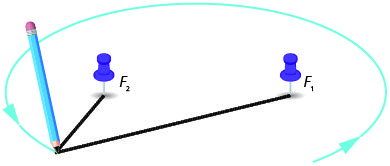
A line drawn through the foci intersect the ellipse in two points. Each point is called a vertex of the ellipse. The segment connecting the vertices is called the major axis. The midpoint of the segment is called the center of the ellipse. A segment perpendicular to the major axis that passes through the center and intersects the ellipse in two points is called the minor axis.

We mentioned earlier that our goal is to connect the geometry of a conic with algebra. Placing the ellipse on a rectangular coordinate system gives us that opportunity. In the figure, we placed the ellipse so the foci ![]() are on the x-axis and the center is the origin.
are on the x-axis and the center is the origin.

The definition states the sum of the distance from the foci to a point ![]() is constant. So
is constant. So ![]() is a constant that we will call
is a constant that we will call ![]() so,
so, ![]() We will use the distance formula to lead us to an algebraic formula for an ellipse.
We will use the distance formula to lead us to an algebraic formula for an ellipse.

To graph the ellipse, it will be helpful to know the intercepts. We will find the x-intercepts and y-intercepts using the formula.

The standard form of the equation of an ellipse with center ![]() is
is
The x-intercepts are ![]() and
and ![]()
The y-intercepts are ![]() and
and ![]()
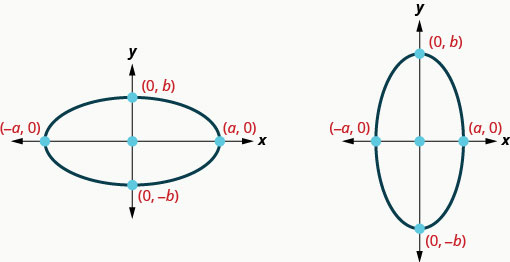
Notice that when the major axis is horizontal, the value of a will be greater than the value of b and when the major axis is vertical, the value of b will be greater than the value of a. We will use this information to graph an ellipse that is centered at the origin.
| Ellipse with Center |
||
|---|---|---|
| Major axis | on the x– axis. | on the y-axis. |
| x-intercepts | ||
| y-intercepts | ||
Graph: ![]()




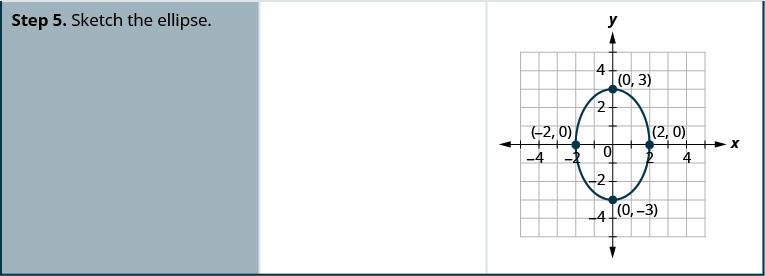
Graph: ![]()
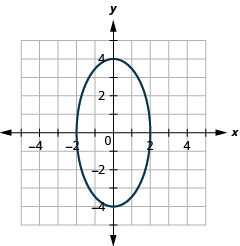
Graph: ![]()
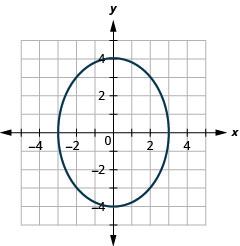
We summarize the steps for reference.
- Write the equation in standard form.
- Determine whether the major axis is horizontal or vertical.
- Find the endpoints of the major axis.
- Find the endpoints of the minor axis
- Sketch the ellipse.
Sometimes our equation will first need to be put in standard form.
Graph ![]()
| We recognize this as the equation of an ellipse since both the x and y terms are squared and have different coefficients. |
|
| To get the equation in standard form, divide both sides by 16 so that the equation is equal to 1. |
|
| Simplify. | |
| The equation is in standard form. The ellipse is centered at the origin. |
The center is |
| Since the major axis is horizontal. |
|
| |
The vertices are The endpoints of the minor axis are |
| Sketch the parabola. |  |
Graph ![]()
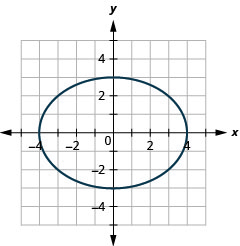
Graph ![]()
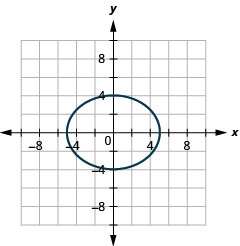
Find the Equation of an Ellipse with Center at the Origin
If we are given the graph of an ellipse, we can find the equation of the ellipse.
Find the equation of the ellipse shown.
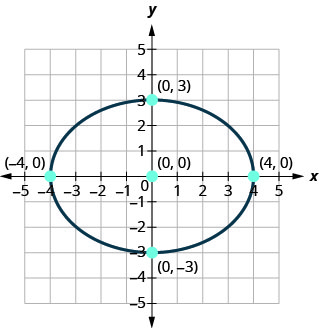

Find the equation of the ellipse shown.
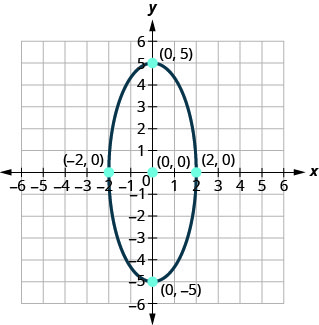
![]()
Find the equation of the ellipse shown.
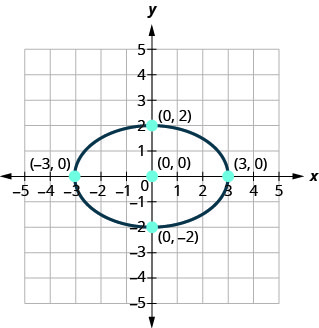
![]()
Graph an Ellipse with Center Not at the Origin
The ellipses we have looked at so far have all been centered at the origin. We will now look at ellipses whose center is ![]()
The equation is ![]() and when
and when ![]() the major axis is horizontal so the distance from the center to the vertex is a. When
the major axis is horizontal so the distance from the center to the vertex is a. When ![]() the major axis is vertical so the distance from the center to the vertex is b.
the major axis is vertical so the distance from the center to the vertex is b.
The standard form of the equation of an ellipse with center ![]() is
is
When ![]() the major axis is horizontal so the distance from the center to the vertex is a.
the major axis is horizontal so the distance from the center to the vertex is a.
When ![]() the major axis is vertical so the distance from the center to the vertex is b.
the major axis is vertical so the distance from the center to the vertex is b.
Graph: ![]()
| The equation is in standard form, |
|
| The ellipse is centered at |
The center is |
| Since the major axis is horizontal. |
|
| |
The distance from the center to the vertices is 3. The distance from the center to the endpoints of the minor axis is 2. |
| Sketch the ellipse. | 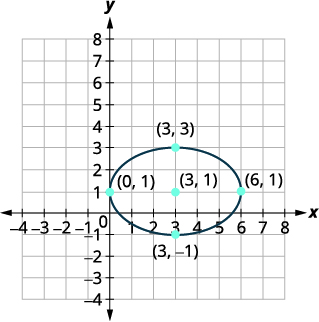 |
Graph: ![]()
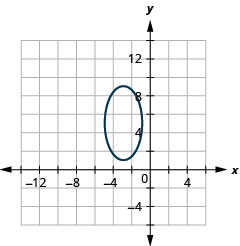
Graph: ![]()
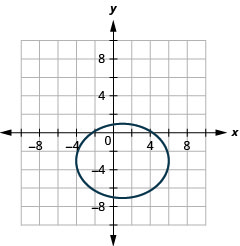
If we look at the equations of ![]() and
and ![]() we see that they are both ellipses with
we see that they are both ellipses with ![]() and
and ![]() So they will have the same size and shape. They are different in that they do not have the same center.
So they will have the same size and shape. They are different in that they do not have the same center.
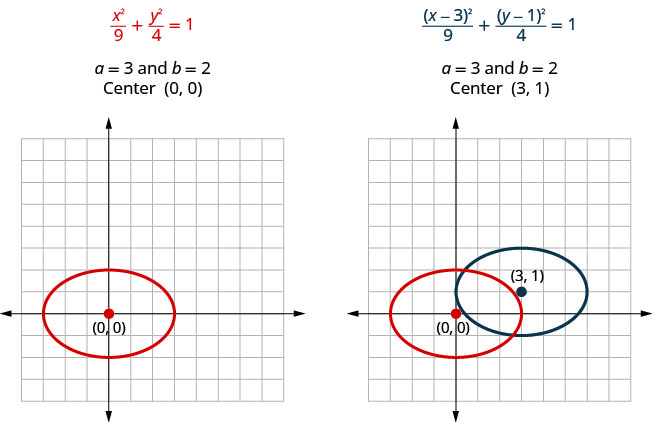
Notice in the graph above that we could have graphed ![]() by translations. We moved the original ellipse to the right 3 units and then up 1 unit.
by translations. We moved the original ellipse to the right 3 units and then up 1 unit.
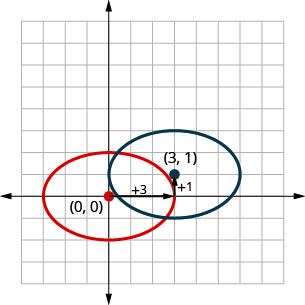
In the next example we will use the translation method to graph the ellipse.
Graph ![]() by translation.
by translation.
This ellipse will have the same size and shape as ![]() whose center is
whose center is ![]() We graph this ellipse first.
We graph this ellipse first.
| The center is |
Center |
| Since |
|
| |
The vertices are The endpoints of the minor axis are |
| Sketch the ellipse. | 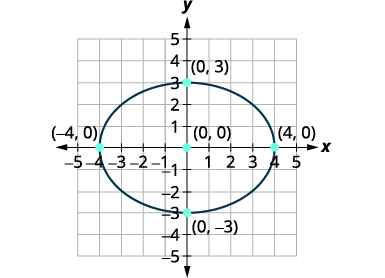 |
| The original equation is in standard form, |
|
| The ellipse is centered at |
The center is |
| We translate the graph of units to the left and then up 6 units. Verify that the center is The new ellipse is the ellipse whose equation is |
 |
Graph ![]() by translation.
by translation.

Graph ![]() by translation.
by translation.
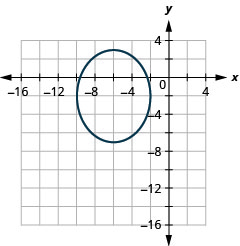
When an equation has both an ![]() and a
and a ![]() with different coefficients, we verify that it is an ellipsis by putting it in standard form. We will then be able to graph the equation.
with different coefficients, we verify that it is an ellipsis by putting it in standard form. We will then be able to graph the equation.
Write the equation ![]() in standard form and graph.
in standard form and graph.
We put the equation in standard form by completing the squares in both x and y.
| Rewrite grouping the x terms and y terms. |  |
| Make the coefficients of |
 |
| Complete the squares. |  |
| Write as binomial squares. |  |
| Divide both sides by 16 to get 1 on the right. |  |
| Simplify. |  |
| The equation is in standard form, |
 |
| The ellipse is centered at |
The center is |
| Since the major axis is horizontal. |
The distance from the center to the vertices is 4. The distance from the center to the endpoints of the minor axis is 2. |
| Sketch the ellipse. | 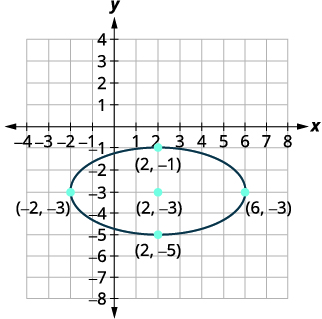 |
ⓐ Write the equation ![]() in standard form and ⓑ graph.
in standard form and ⓑ graph.
ⓐ![]()
ⓑ
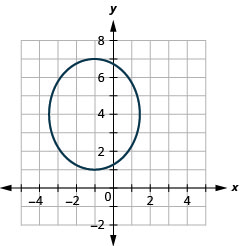
ⓐ Write the equation ![]() in standard form and ⓑ graph.
in standard form and ⓑ graph.
ⓐ![]()
ⓑ
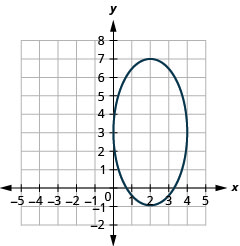
Solve Application with Ellipses
The orbits of the planets around the sun follow elliptical paths.
Pluto (a dwarf planet) moves in an elliptical orbit around the Sun. The closest Pluto gets to the Sun is approximately 30 astronomical units (AU) and the furthest is approximately 50 AU. The Sun is one of the foci of the elliptical orbit. Letting the ellipse center at the origin and labeling the axes in AU, the orbit will look like the figure below. Use the graph to write an equation for the elliptical orbit of Pluto.
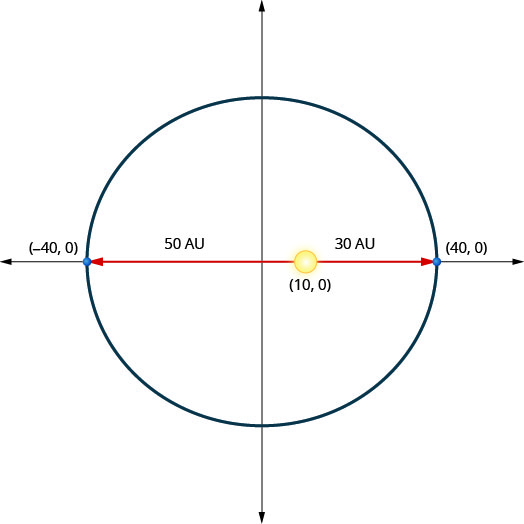

A planet moves in an elliptical orbit around its sun. The closest the planet gets to the sun is approximately 20 AU and the furthest is approximately 30 AU. The sun is one of the foci of the elliptical orbit. Letting the ellipse center at the origin and labeling the axes in AU, the orbit will look like the figure below. Use the graph to write an equation for the elliptical orbit of the planet.
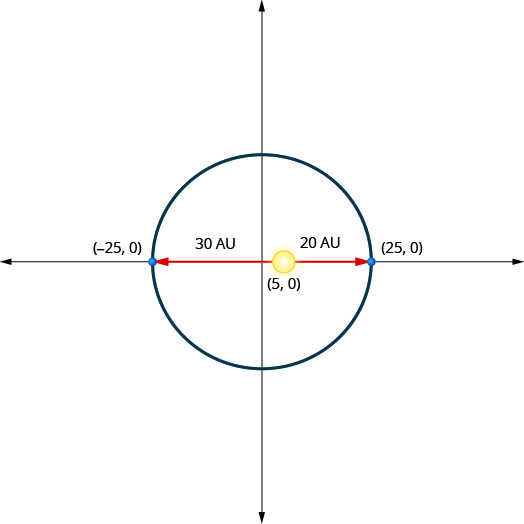
![]()
A planet moves in an elliptical orbit around its sun. The closest the planet gets to the sun is approximately 20 AU and the furthest is approximately 50 AU. The sun is one of the foci of the elliptical orbit. Letting the ellipse center at the origin and labeling the axes in AU, the orbit will look like the figure below. Use the graph to write an equation for the elliptical orbit of the planet.
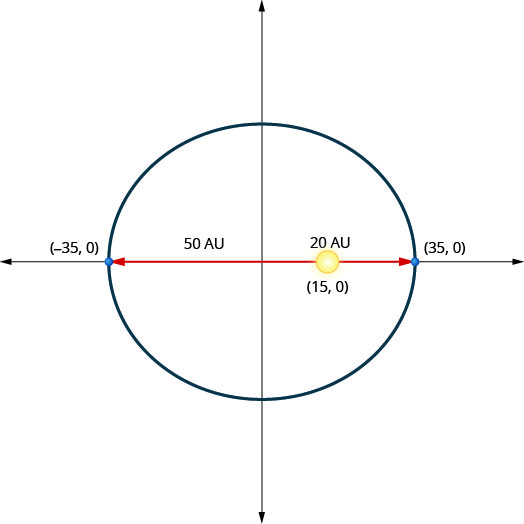
![]()
Access these online resources for additional instructions and practice with ellipses.
Key Concepts
- Ellipse: An ellipse is all points in a plane where the sum of the distances from two fixed points is constant. Each of the fixed points is called a focus of the ellipse.
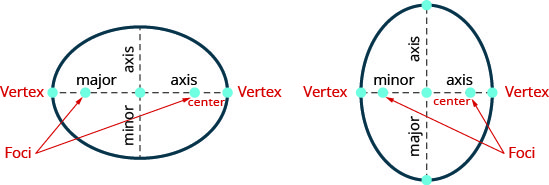
If we draw a line through the foci intersects the ellipse in two points—each is called a vertex of the ellipse.
The segment connecting the vertices is called the major axis.
The midpoint of the segment is called the center of the ellipse.
A segment perpendicular to the major axis that passes through the center and intersects the ellipse in two points is called the minor axis. - Standard Form of the Equation an Ellipse with Center
 The standard form of the equation of an ellipse with center
The standard form of the equation of an ellipse with center  is
is

The x-intercepts are and
and 
The y-intercepts are and
and 
- How to an Ellipse with Center

- Write the equation in standard form.
- Determine whether the major axis is horizontal or vertical.
- Find the endpoints of the major axis.
- Find the endpoints of the minor axis
- Sketch the ellipse.
- Standard Form of the Equation an Ellipse with Center
 The standard form of the equation of an ellipse with center
The standard form of the equation of an ellipse with center  is
is

When the major axis is horizontal so the distance from the center to the vertex is a.
the major axis is horizontal so the distance from the center to the vertex is a.
When the major axis is vertical so the distance from the center to the vertex is b.
the major axis is vertical so the distance from the center to the vertex is b.
Practice Makes Perfect
Graph an Ellipse with Center at the Origin
In the following exercises, graph each ellipse.
![]()
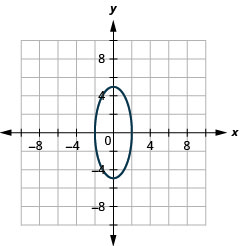
![]()
![]()
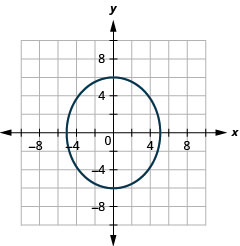
![]()
![]()
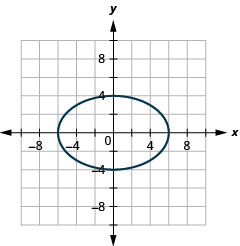
![]()
![]()
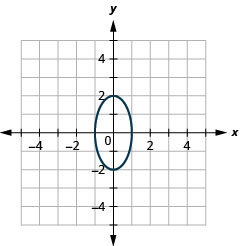
![]()
![]()
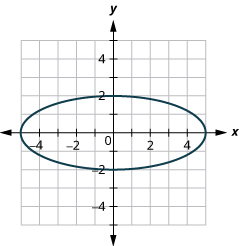
![]()
![]()
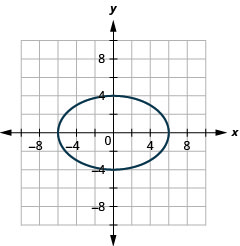
![]()
Find the Equation of an Ellipse with Center at the Origin
In the following exercises, find the equation of the ellipse shown in the graph.
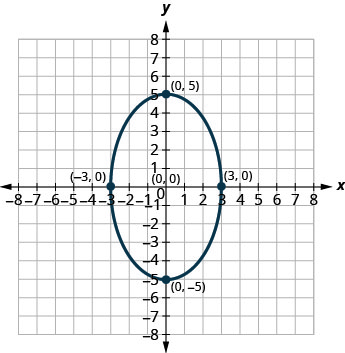
![]()
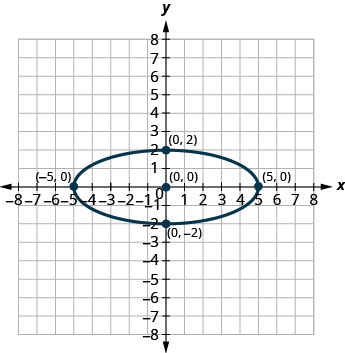
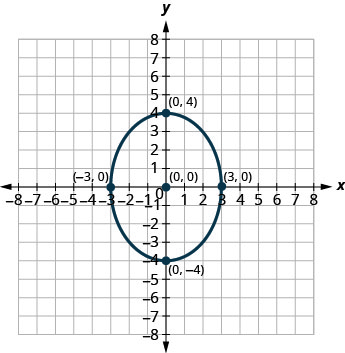
![]()
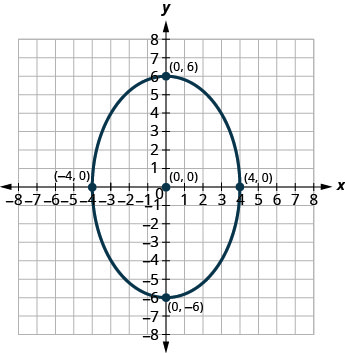
Graph an Ellipse with Center Not at the Origin
In the following exercises, graph each ellipse.
![]()
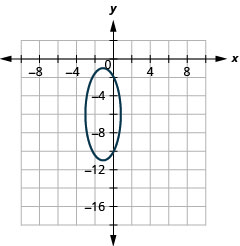
![]()
![]()
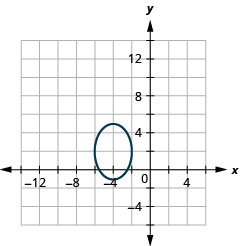
![]()
In the following exercises, graph each equation by translation.
![]()
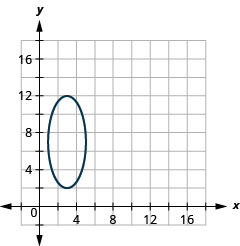
![]()
![]()
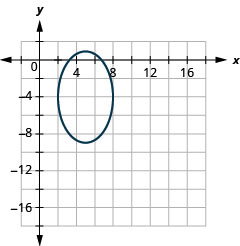
![]()
In the following exercises, ⓐ write the equation in standard form and ⓑ graph.
![]()
ⓐ![]()
ⓑ
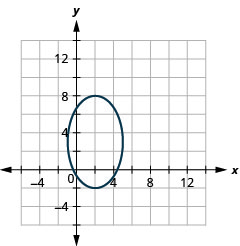
![]()
![]()
ⓐ![]()
ⓑ
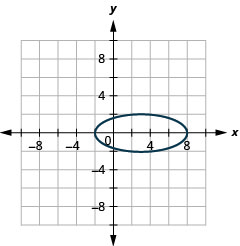
![]()
In the following exercises, graph the equation.
![]()
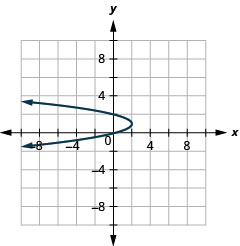
![]()
![]()

![]()
![]()
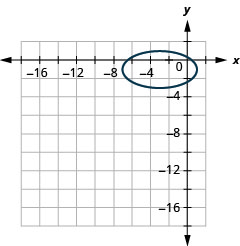
![]()
![]()
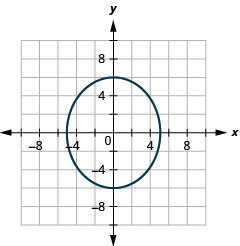
![]()
![]()
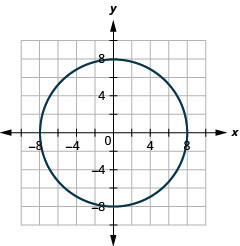
![]()
![]()
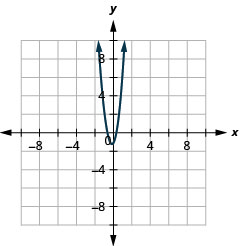
![]()
Solve Application with Ellipses
A planet moves in an elliptical orbit around its sun. The closest the planet gets to the sun is approximately 10 AU and the furthest is approximately 30 AU. The sun is one of the foci of the elliptical orbit. Letting the ellipse center at the origin and labeling the axes in AU, the orbit will look like the figure below. Use the graph to write an equation for the elliptical orbit of the planet.
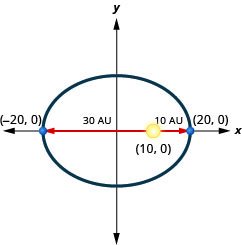
![]()
A planet moves in an elliptical orbit around its sun. The closest the planet gets to the sun is approximately 10 AU and the furthest is approximately 70 AU. The sun is one of the foci of the elliptical orbit. Letting the ellipse center at the origin and labeling the axes in AU, the orbit will look like the figure below. Use the graph to write an equation for the elliptical orbit of the planet.
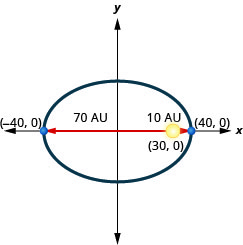
A comet moves in an elliptical orbit around a sun. The closest the comet gets to the sun is approximately 15 AU and the furthest is approximately 85 AU. The sun is one of the foci of the elliptical orbit. Letting the ellipse center at the origin and labeling the axes in AU, the orbit will look like the figure below. Use the graph to write an equation for the elliptical orbit of the comet.
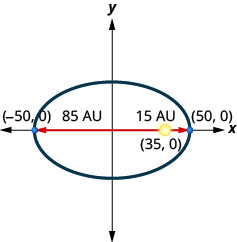
![]()
A comet moves in an elliptical orbit around a sun. The closest the comet gets to the sun is approximately 15 AU and the furthest is approximately 95 AU. The sun is one of the foci of the elliptical orbit. Letting the ellipse center at the origin and labeling the axes in AU, the orbit will look like the figure below. Use the graph to write an equation for the elliptical orbit of the comet.
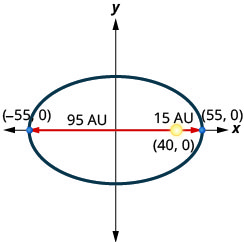
Writing Exercises
In your own words, define an ellipse and write the equation of an ellipse centered at the origin in standard form. Draw a sketch of the ellipse labeling the center, vertices and major and minor axes.
Answers will vary.
Explain in your own words how to get the axes from the equation in standard form.
Compare and contrast the graphs of the equations ![]() and
and ![]()
Answers will vary.
Explain in your own words, the difference between a vertex and a focus of the ellipse.
Self Check
ⓐ After completing the exercises, use this checklist to evaluate your mastery of the objectives of this section.

ⓑ What does this checklist tell you about your mastery of this section? What steps will you take to improve?
Glossary
- ellipse
- An ellipse is all points in a plane where the sum of the distances from two fixed points is constant.

